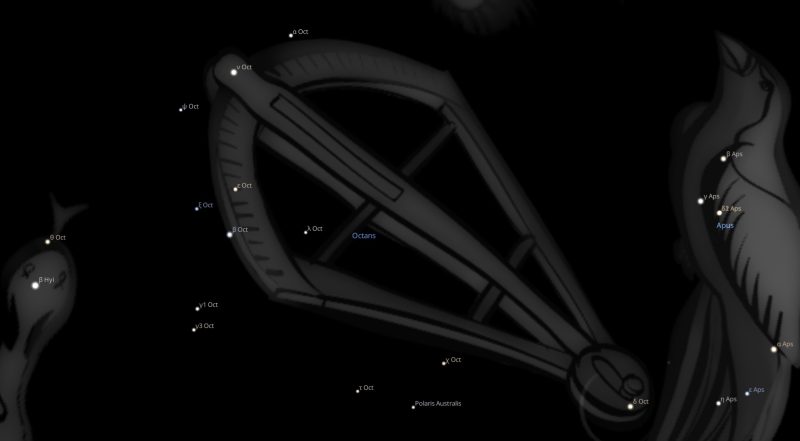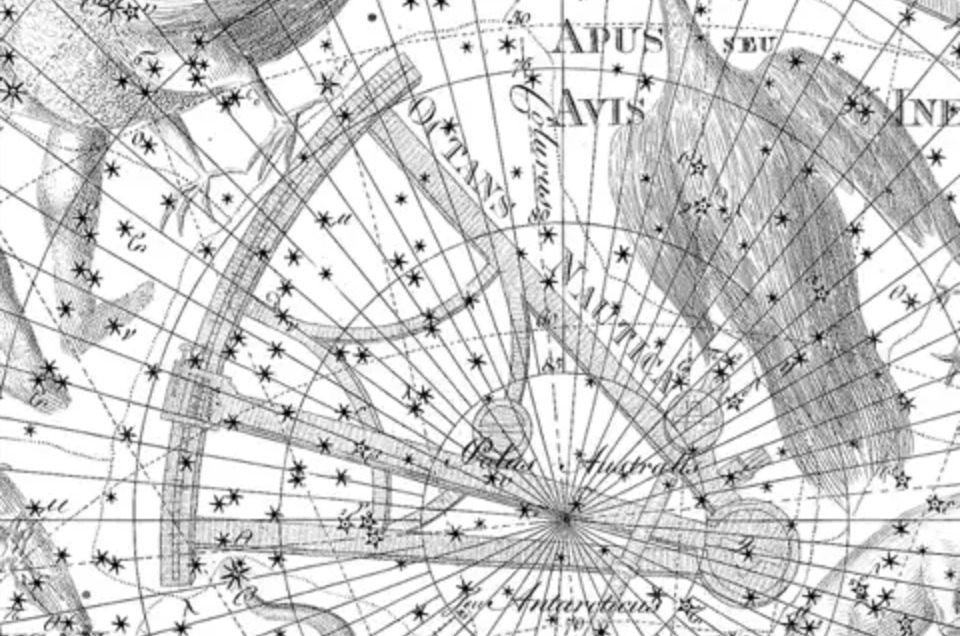FIXED STARS: Major Stars | 1000+ Stars | Constellations | About
Constellation Octans The Octant is a southern constellation bordering Apus, Chamaeleon, Mensa, Hydrus, Tucana and Pavo.Octans was introduced by Nicolas-Louis de Lacaille in 1752 and remains one of the 88 modern constellations. It spans 50 degrees of the zodiac in the Signs of Sagittarius, Capricorn and Aquarius.
Abbreviation: Oct
Genitive: Octantis
Octans Constellation Stars
| 2000 | 2050 | Star | Name | Sp. Class | Mag. | Orb |
|---|---|---|---|---|---|---|
| 19♐01 | 19♐43 | δ Oct | K2 | 4.31 | 1°10′ | |
| 01♑51 | 02♑34 | σ Oct | Polaris Australis | F0 | 5.45 | 1°00′ |
| 18♑00 | 18♑43 | β Oct | A9 | 4.13 | 1°20′ | |
| 19♑41 | 20♑23 | ν Oct | K0 | 3.76 | 1°30′ | |
| 00♒05 | 00♒47 | θ Oct | K2 | 4.78 | 1°00′ |
σ Oct is officially named Polaris Australis, Latin for the “South Pole Star.” It is positioned one degree from the southern celestial pole, in nearly direct opposition to the North Star, Polaris.
Octans Astrology
Robson
OCTANS HADLEIANUS. Hadley’s Octant.
History. Formed by La Caille in 1752 in recognition of the octant invented in 1730 by John Hadley. It is now usually abbreviated to Octancs.
Influence. It is said to give a scientific mind marred by ill-regulated passions, psychic disturbances and discord. [1]
Allen
Octans Hadleianus, now known simply as Octans, was formed and published by La Caille in 1752 in recognition of the octant invented in 1730 by John Hadley.
Gould assigns to it 88 naked-eye stars down to the 7th magnitude; the brightest, ν, being only of 3.8; but the constellation is noteworthy as marking the south pole, its 5.8‑magnitude σ being about ¾ of a degree away. A straight line from α Crucis to β Hydri almost touches the pole at ⅓ of the distance from the latter star.
Pliny [N. H. V.69] tells us that the Hindus had given it a name, Dramasa, —
Austrinum Polum Indi Dramasa vocant.
The heathen Arabs, too, seem to have had some knowledge of it, for they imagined that, like its northern counterpart, it exercised a healing power on all afflicted persons who would attentively observe it. [2]
References
- Fixed Stars and Constellations in Astrology, Vivian E. Robson, 1923, p.53-54.
- Star Names: Their Lore and Meaning, Richard H. Allen, 1889, p.296.

